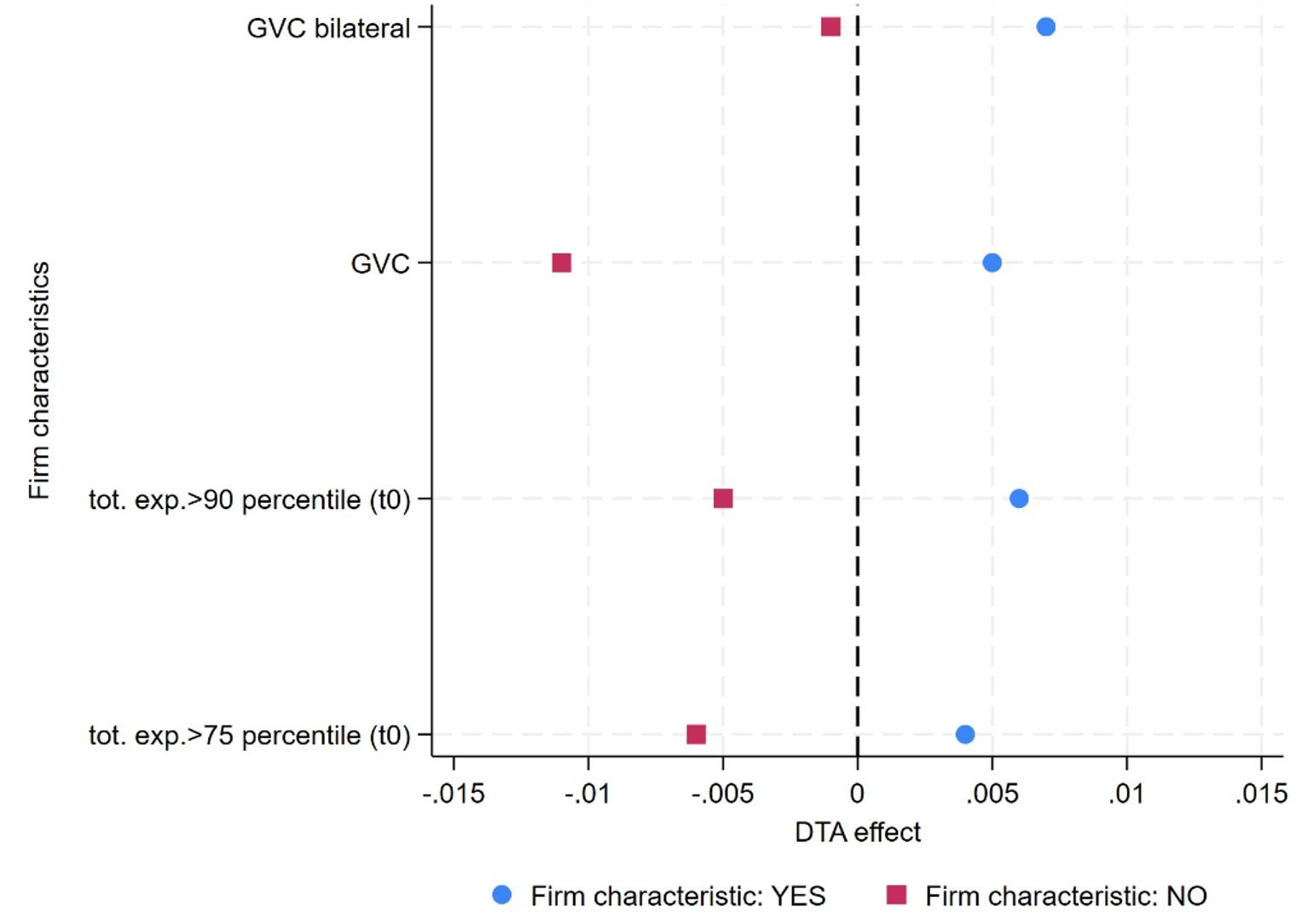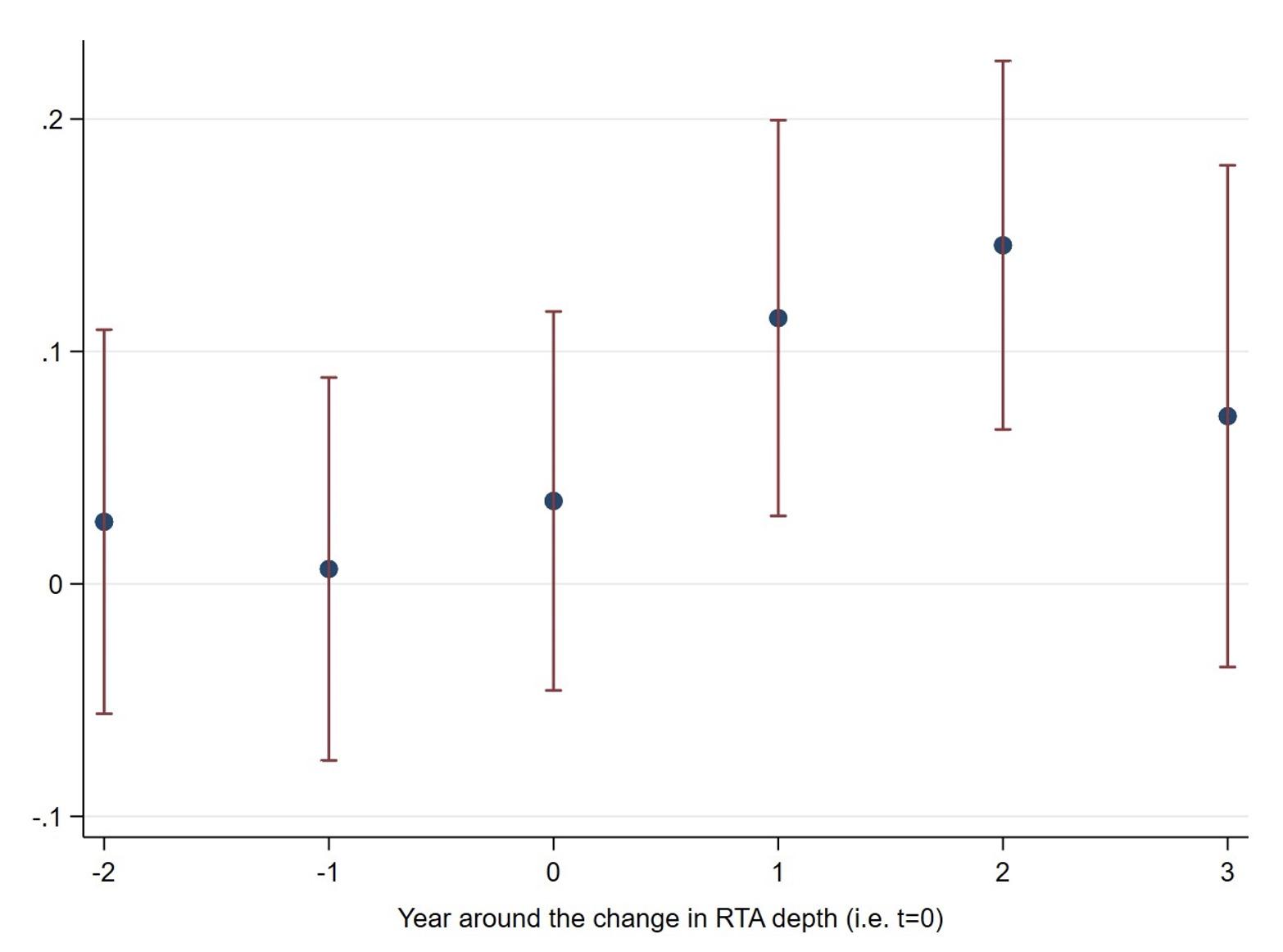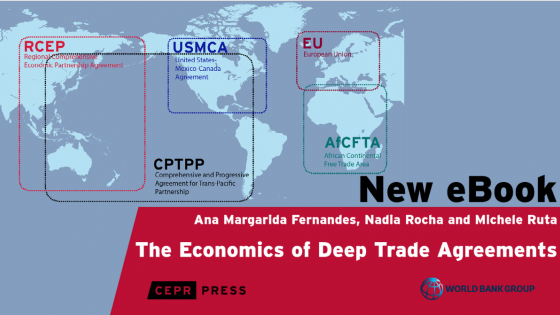Many developing countries have signed deep regional trade agreements (RTAs) during the last two decades with the aim of better integrating their economies and improving the export performance of firms (Hofmann et al. 2017, Mattoo et al. 2020). While a large body of literature focuses on aggregate trade flows (e.g. Baier et al. 2019, Orefice and Rocha 2011, Mattoo et al. 2022, Dhingra et al. 2021, Fernandes et al. 2021), there is little understanding of how deep trade agreements impact on firms.
Our recent research (Neri-Lainé et al. 2023) shows that, in line with the new new trade theory, the effect of deep trade agreements depends on the firms' characteristics. Large firms and firms involved in global value chains (GVCs) benefit the most from the enforcement of deep trade agreement, while small firms suffer the increased competition at destination (pro-competitive effect) and may exit from the export market (selection effect). These effects have important implications for the welfare of signatory countries that were neglected by the existing literature on the consequences of deep trade agreements.
Firm-level effects of deeper trade agreements
We empirically investigate the effect of deep trade agreements on the export performance of heterogeneous firms. The analysis combines firm-level export data for 31 developing countries for the period 2000-2020 from the World Bank Exporter Dynamics Database (Fernandes et al. 2016) with detailed information on the content of more than 300 RTAs from the World Bank Deep Trade Agreements database (Hofmann et al. 2017). We adapt the standard gravity model for trade (Head and Mayer 2014) to firm-level analysis in which we include a variable capturing the depth of RTAs. Namely, we construct several proxies of RTAs’ depth based on the policy areas covered by the agreements and their legal enforceability: (1) total number of provisions (independently of their legal enforceability); (2) number of legally enforceable provisions (i.e. whose implementation is supported by strong legal language and by the availability of a dispute settlement mechanism) – our preferred measure; (3) number of provisions covered by the current mandate of the WTO (WTO+); (4) number of provisions not covered by the current mandate of the WTO (WTO-X); and (5) number of provisions directly related to trade enhancing factors.
We apply a standard difference in difference approach controlling for any firm-year, destination-year, and origin-destination specific factor affecting the export performances of firms. We identify the effect of the deep trade agreements based on the change in the depth of RTAs between origin and destination country (i.e. newly signed PTAs or amendment of pre-existing ones). Specifically, we compare a given firm’s exports towards destinations having experienced changes in RTA depth with those towards destinations that had no change in RTA depth (conditional on any firm-and destination-specific shock). Baseline results, using the number of legally enforceable provisions in RTAs as a proxy for their depth, show that one additional legally enforceable policy area in RTAs increases firms' exports by 0.3%, on average. Moving from shallow RTAs (i.e. agreements with only tariff cuts) to deep RTAs (i.e. in the 75th percentile of RTA depth) corresponds to a 3.6% rise in firms' exports.
Different firms, different effects
The average effect of deep RTAs on the export performance of firms hides significant heterogeneity depending on firms' characteristics. Figure 1 summarises the effect of deep RTAs by firm type: (1) GVC versus non-GVC firms (respectively squares and circles in Figure 1), and (2) large versus small firms (respectively squares and circles in Figure 1). In line with models of trade with heterogeneous firms and pricing behaviour (Atkeson and Burstein, 2008), we show that large and highly productive firms benefit while small and less productive firms suffer from deep RTAs. On average, including an additional legally enforceable provision in RTAs stimulates large firms' exports by 0.4–0.6% and reduces small firms' exports by 0.5–0.6%. Furthermore, firms participating in global value chains, i.e. firms that export and import to/from the same country benefit the most from the RTAs.
Figure 1 The heterogeneous trade effect of deep PTAs by firm characteristics
Note: Heterogeneity variables are estimated separately. Regressions includes firm-year, destination-year and origin-destination fixed effects. We control for tariffs. Standard errors are clustered by origin-destination-year.
The pro-competitive effect identified in our research highlights the importance of using firm-level data to understand the welfare implications of RTAs. Specifically, by improving the export performance of larger, more productive, and better-connected firms and reducing that of smaller, less productive, and less connected firms, deep trade agreements generate a reallocation of resources from the latter group to the former. This leads to an overall increase in the average productivity of firms in the exporting country and a decrease in the average price for imported varieties in the importing country (a welfare gain for developing countries signing the dee trade agreement). However, this reallocation of resources also entails adjustment costs as small firms exit export markets due to the increased competition at destination.
Dynamic effects
We also analyse the dynamic effect of deep trade agreements on firms' exports using an event study approach. In Figure 2 we show the effect of RTA depth on treated firms (i.e. firms exporting towards destination with a change in RTA depth) around the year of the change in RTA depth (t0 in Figure 2). Regression includes firm-year, destination-year, and origin-destination fixed effects; the reference year is t=-3.
Figure 2 Firm exports event study
Note: Figure plots event time dummies for targeted firms relative to untargeted firms. Regression includes firm-year, destination-year and origin-destination fixed effects. Standard errors are clustered by origin-destination-year. Error bars show 90% confidence intervals.
Two important messages emerge from the event study. First, before the change in RTA depth, treated and untreated firms (i.e. respectively those that experienced and did not experience a change in the depth of RTAs at destination) do not differ in their export performance. The absence of a pre-trend corroborates the causal interpretation of our earlier findings. Second, after the change in the depth of RTAs, treated firms export more into destinations that have signed a deep RTA with the country of origin. This a positive effect vanishes after three years, which could reflect the increasing number of deep RTAs in the world (and the consequent reduction in market access towards other destinations) and the enforcement of non-discriminatory provisions in RTAs that de facto reduce trade costs for exporters in non-member countries. The increasing number of preferential trade agreements in the world (Hofmann et al. 2017) gives preferential market access towards a wider set of destinations, makes the existing trade agreements less ‘unique’ and hence reduces their effectiveness in boosting bilateral trade. Also, non-discriminatory provisions in deep trade agreements apply to non-signatory countries. This makes exporters from third countries benefit from deep trade agreements, reducing the preferential nature of RTAs and hence eroding the advantage of firms in signatory countries (Lee et al. 2023).
Final remarks
Our paper uncovers important welfare and policy implications of deep trade agreements signed by developing countries. By reallocating resources toward larger, more productive, and better-connected firms, the pro-competitive selection effect of deep RTAs is expected to improve member countries’ welfare. Yet, the negative impact on the export performance of small firms that have lower productivity and are not integrated in global value chains signals the presence of a costly adjustment process which calls for appropriate domestic policies to complement deep integration.
Authors’ note: The views expressed in this column are those of the authors and they do not necessarily represent the views of the institutions they work for.
References
Atkeson, A and A Burstein (2008), “Pricing-to-market, trade costs, and international relative prices”, American Economic Review 98(5): 1998–2031.
Baier, S L, Y V Yotov and T Zylkin (2019), “On the widely differing effects of free trade agreements: Lessons from twenty years of trade integration”, Journal of International Economics 116: 206–226.
Dhingra, S, R Freeman and H Huang (2021), “The Trade and Welfare Benefits of Deep Trade Agreements”, VoxEU.org, 21 January.
Fernandes, A M, C Freund and M D Pierola (2016), “Exporter behavior, country size and stage of development: Evidence from the exporter dynamics database”, Journal of Development Economics 119: 121–137.
Fernandes, A, N Rocha and M Ruta (2021), The Economics of Deep Trade Agreements, CEPR Press.
Head, K and T Mayer (2014), “Gravity equations: Workhorse, toolkit, and cookbook”, Chapter 4 in G Gopinath, E Helpman and K Rogoff (eds), Handbook of International Economics, Vol. 4.
Hofmann, C, A Osnago and M Ruta (2017), “Horizontal depth: A new database on the content of preferential trade agreements”, World Bank Policy Research Working Paper 7981.
Lee, W, A Mulabdic, and M Ruta (2023), “Third-Country Effects of Regional Trade Agreements: A Firm-Level Analysis”, Journal of International Economics 140.
Mattoo, A, A Mulabdic, and M Ruta (2022), “Trade creation and trade diversion in deep agreements”, Canadian Journal of Economics/Revue canadienne d'économique 55: 1598-1637.
Mattoo, A, N Rocha, and M Ruta (2020), Handbook of deep trade agreements, World Bank Publications.
Neri-Lainé, M, G Orefice and M Ruta (2023), “Deep Trade Agreements and Heterogeneous Firms Exports”, World Bank Policy Research Working Paper 10277.
Orefice, G and N Rocha (2011), “Deep Integration and Production Networks”, CEPR Policy Insight No. 60.








